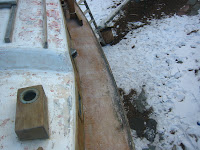I took these shots of the boat yesterday, before the Valentine's day "blizzard".

The frame on the stern was built by one of the last two owners. Not sure who, but it does a great job of keeping the snow up and out of the way. I can still crawl into and out of the boat without a problem and work on the cockpit even when its snowing.
 Port.
Port. I'm still amazed at the great shape of this hull. There is some crazing and very minor spider cracks where the
stanchions were. There is also one dime-sized nick in the gel coat off the starboard transom.
 The rudder.
The rudder.

Close up.
 Up over the port side of the transom.
Up over the port side of the transom. Here you can see that the toe rail has been removed all together. You can also see the condition of the deck. There's one layer of marine ply joining the deck to the hull. Looks like this deck has seen some weather over the last few years, but
thankfully the glass on it did to protect the wood. Another course of ply is needed to bring the height of the deck up to where it was when it was a laid teak deck. I know that
I'm not putting teak back down on this because of the cost (and because I want to get in the water before my kid's in college). That said, I haven't decided how I'm finishing it (what to cover the ply with). Right now I'm thinking of using
Dynel because from what I've read, it looks allot like traditional canvas and is sturdy as hell.

Another shot. The tiller is off and in the basement being sanded and varnished.

 Cockpit area.
Cockpit area. The owner before last started to replace the seats and did a great job. None of this wood needs replacing. Some TSP/bleach for the seats and lots of teak brightener/varnish for the rest. There are some nice (original?) teak floor grates that are also inside being cleaned up. The controls for the motor will be here, assuming we can get the motor running. Not sure what the small square section is just aft of the motor well cover. Stuffing box access? What ever it was doesn't open now.
 Long starboard locker.
Long starboard locker. Everything here is in great shape and needs minimal attention. That varnish on the undersides gives me hope that these things will clean up nice.
 Shorter starboard locker
Shorter starboard locker, closer to the companionway. The fuel tank was set up in here and will likely stay here unless something else needs the space (like outside access to an icebox). How great would it be to be able to grab a refreshing cool beverage on a hot day without having to wait for someone to go down below?
 Port side windows.
Port side windows. On more recent models like 67's and 68's, the cabin house is fiberglass with teak boards attached to the outside and a teak veneer on the inside. On this boat, the cabin is solid teak through out and is topped with marine ply and glass. There are a couple of spots where the boards have separated. Need to address this before any varnish.
 Port Dorade.
Port Dorade.
 Cabin top, hatches and grab rails.
Cabin top, hatches and grab rails. Original teak rails. Good shape considering their age. Will likely make new ones this winter. Black locust? I was able to scrape and sand all this before the storm hit and it is all in great shape. This will be a quick fix when the weather warms up. Nice bright white cabin tops.
Font of doghouse
 Bow deck
Bow deck. No rot anywhere (so far).

 the fastest around, she is responsive enough to be very enjoyable to sail. When the going gets tough, she was and still is unrivalled. No matter what, the pressure on the tiller will hardly increase and she can be trimmed in such a way that any over dose of wind can be dealt with easily. The Folkboat is not only fun to race, but also safe to cruise. She is plain beautiful!
the fastest around, she is responsive enough to be very enjoyable to sail. When the going gets tough, she was and still is unrivalled. No matter what, the pressure on the tiller will hardly increase and she can be trimmed in such a way that any over dose of wind can be dealt with easily. The Folkboat is not only fun to race, but also safe to cruise. She is plain beautiful! The seaworthiness of the Folkboat made her a source of inspiration for many sailors. In the late nineteen fifties the first long distance voyages using Folkboats were undertaken. Some of these voyages included a trip in 1962 by Adrian Hayter, who sailed his Valkyr westwards from England to New Zealand. Then between 1975 and 1977 Australian Ann Gash circum navigated the Globe single-handedly in another Folkboat, Ilimo. But perhaps the best known long distance Folkboat is Jester, which was sailed by "Blondie" Hasler who single- handedly crossed the Trans Atlantic in 1960."
The seaworthiness of the Folkboat made her a source of inspiration for many sailors. In the late nineteen fifties the first long distance voyages using Folkboats were undertaken. Some of these voyages included a trip in 1962 by Adrian Hayter, who sailed his Valkyr westwards from England to New Zealand. Then between 1975 and 1977 Australian Ann Gash circum navigated the Globe single-handedly in another Folkboat, Ilimo. But perhaps the best known long distance Folkboat is Jester, which was sailed by "Blondie" Hasler who single- handedly crossed the Trans Atlantic in 1960."